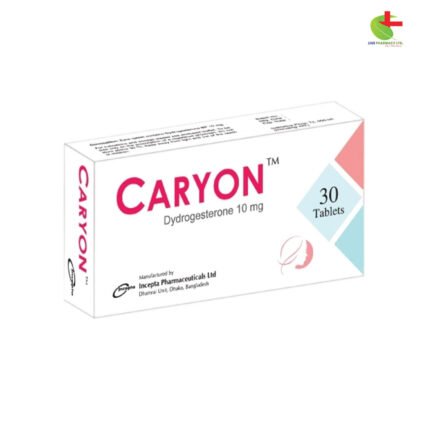Duloxen 60
160.00৳ Strip(10)
- Duloxen is a serotonin-norepinephrine reuptake inhibitor (SNRI) used to treat Major Depressive Disorder (MDD), Generalized Anxiety Disorder (GAD), Diabetic Peripheral Neuropathic Pain (DPNP), Fibromyalgia, and Chronic Musculoskeletal Pain.
- It helps restore the balance of serotonin and norepinephrine in the brain, improving mood and reducing pain.
- Duloxen is available in various doses, with the recommended dose depending on the condition being treated.
- Always consult with a healthcare professional before starting or adjusting the dosage.
 Brand
Brand
|
Incepta Pharmaceuticals Ltd |
|---|---|
 Generics
Generics
|
Duloxetine Hydrochloride |
 Type
Type
|
Tablet |
Indications
Duloxen, a serotonin-norepinephrine reuptake inhibitor (SNRI), is prescribed for the treatment of:
- Major Depressive Disorder (MDD)
- Generalized Anxiety Disorder (GAD)
- Diabetic Peripheral Neuropathic Pain (DPNP)
- Fibromyalgia
- Chronic Musculoskeletal Pain
Always follow the advice of a registered healthcare provider when using this medication.
Pharmacology
Duloxetine Hydrochloride, an SSNRI, is taken orally and primarily inhibits the reuptake of serotonin and norepinephrine. It has a weaker effect on dopamine reuptake. Duloxetine does not significantly bind to adrenergic, cholinergic, histaminergic, glutamate, GABA, or opioid receptors, nor does it inhibit monoamine oxidase (MAO). It is well absorbed when taken orally, and its elimination occurs primarily through liver metabolism.
Dosage & Administration
- For Major Depressive Disorder (MDD):
- Starting Dose: 40–60 mg/day
- Target Dose: 40 mg/day (20 mg twice daily) to 60 mg/day (once daily or 30 mg twice daily)
- Maximum Dose: 120 mg/day
- For Generalized Anxiety Disorder (GAD):
- Starting Dose: 60 mg/day
- Target Dose: 60 mg/day (once daily)
- Maximum Dose: 120 mg/day
- For Diabetic Peripheral Neuropathic Pain (DPNP):
- Starting Dose: 60 mg/day
- Target Dose: 60 mg/day (once daily)
- Maximum Dose: 60 mg/day
- For Fibromyalgia:
- Starting Dose: 30 mg/day
- Target Dose: 60 mg/day (once daily)
- Maximum Dose: 60 mg/day
- For Chronic Musculoskeletal Pain:
- Starting Dose: 30 mg/day
- Target Dose: 60 mg/day (once daily)
- Maximum Dose: 60 mg/day
For some patients, starting with a lower dose of 30 mg daily may be beneficial. Studies show that doses above 60 mg/day may not offer additional benefits and could lead to increased side effects. A gradual reduction of the dose is advised to avoid withdrawal symptoms.
Always follow the advice of a registered healthcare provider when using this medication.
Drug Interactions
Duloxen is metabolized by both CYP1A2 and CYP2D6 enzymes. Co-administration with potent CYP1A2 inhibitors, like fluvoxamine, may increase Duloxen’s concentration in the bloodstream. Other CYP1A2 inhibitors, such as cimetidine and certain quinolone antibiotics (e.g., ciprofloxacin), may produce similar effects. Concomitant use with CYP2D6 inhibitors may also increase Duloxen levels.
Contraindications
Duloxen should not be used in patients with:
- Known hypersensitivity to Duloxen or any of its ingredients
- Bipolar depression
- Substantial alcohol consumption or chronic liver disease
- Narrow-angle glaucoma (use with caution due to the risk of pupil dilation)
Common Side Effects
The most frequent side effects observed in patients taking Duloxen include:
- Nausea
- Dizziness
- Dry mouth
- Constipation
- Loss of appetite
- Fatigue
- Drowsiness
- Excessive sweating
- Weakness
Some patients may experience a slight increase in blood pressure. No significant differences were observed in QT, PR, and QRS intervals between Duloxen and placebo groups.
Pregnancy & Lactation
- Pregnancy: Category C. Duloxen should only be used during pregnancy if the potential benefits justify the risks to the fetus.
- Labor and Delivery: The effects of Duloxen on labor and delivery are not well known. Use only if the benefits outweigh the potential risks.
- Lactation: It is not known whether Duloxen or its metabolites are excreted in human milk. Nursing is not recommended while on Duloxen.
Precautions & Warnings
- Patients taking Duloxen should be monitored for any worsening of symptoms, suicidal thoughts, or unusual behavior, particularly during the first few months of treatment or after dose adjustments.
- Blood pressure should be measured before starting Duloxen and regularly during treatment.
- Caution is advised when using Duloxen with NSAIDs, aspirin, or other anticoagulants due to the risk of bleeding.
- Use with caution in patients with a history of mania or seizure disorders.
Use in Special Populations
- Pediatric Use: The safety and efficacy of Duloxen in children have not been established.
Overdose Management
There is limited clinical data on Duloxen overdose. In case of an overdose, general treatment measures should be employed. Ensure proper airway management, and monitor cardiac rhythm and vital signs. Activated charcoal may help reduce absorption if administered shortly after ingestion. Inducing vomiting is not recommended.
Therapeutic Class
Serotonin-Norepinephrine Reuptake Inhibitor (SNRI)
Storage Conditions
Store Duloxen at a temperature not exceeding 30°C. Keep away from light and out of reach of children.













Reviews
There are no reviews yet.